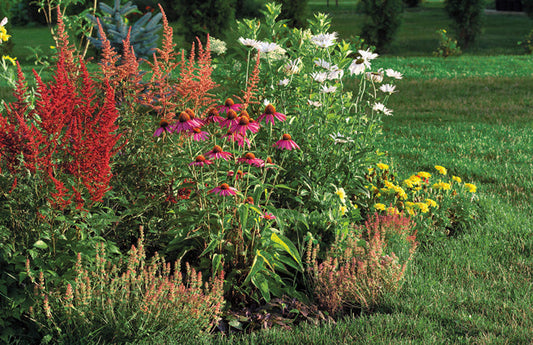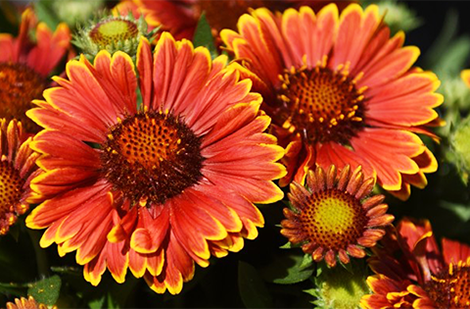Agastache 'Honeysticks Sandstone'
Agastache 'Honeysticks Sandstone'
Agastache 'Honeysticks Sandstone'
Exposure
- Sun
Rusticity
Bloom time
- June
- July
- August
- September
- Bright honey-sand flowers
- Spicy aromatic foliage
- Attracts hummingbirds and pollinators
- Tolerant to heat and drought
- Compact habit, long bloom
Let yourself be charmed by the soft and warm hues of Agastache 'Honeysticks Sandstone', an attractive perennial that adorns the garden with spikes of flowers in subtle shades of peach, apricot, and honey-sand. Just like its relatives, this Agastache is a magnet for pollinators and hummingbirds, while also being deer-resistant. Its aromatic foliage and ease of care make it a valuable addition to any sunny Quebec garden.
Characteristics
- Foliage : The foliage of Agastache 'Honeysticks Sandstone' is dark green with oval leaves that have toothed edges. It is aromatic, although the fragrance may vary slightly from other Agastaches.
- Bloom : This variety produces spikes of flowers in warm and soft colours, ranging from peach to apricot and honey-sand. The bloom extends from June to September, offering a long period of colour in the garden.
- Light : Prefers full sun for optimal flowering. Requires at least 6 hours of direct sunlight per day.
- Habit : Its habit is upright and compact.
- Growth : Reaches a height of approximately 45 cm (18 inches) and a spread of approximately 60 cm (24 inches).
- Humidity : Prefers well-drained soil and is very tolerant of drought once established.
- Soil : Thrives in well-drained soil, even poor soil.
- Temperature : Hardy in zone 4, which is suitable for most regions of Quebec.
- Watering : Water regularly when planting to encourage establishment. Once established, it requires little watering, except during prolonged drought.
Uses
- Types of Use : Ideal for sunny borders, flower beds, rock gardens, cottage gardens, and containers. Its flowers attract pollinators and hummingbirds, making it an excellent choice for wildlife-friendly gardens.
- Decorative Advantages : Its uniquely coloured flowers and aromatic foliage add a touch of softness and interest to the garden. It is also resistant to deer and rabbits.
Care
- Fertilization : A light fertilization in the spring can be beneficial, but it is not essential. Avoid overly rich soils.
- Pruning : Pinch young plants in the spring to encourage bushier growth. Deadhead spent flower spikes to prolong blooming. You can cut back the plant in late fall or early spring.
- Planting :
- Distance : Plant at a distance of approximately 45 to 60 cm (18 to 24 inches) to allow for good growth.
- Depth : Plant at the same level as the top of the root ball in the original container.
- Period : Spring or early fall are the best times for planting.
Plant details
Dimensions
Dimensions
Characteristics
Characteristics
Habit:
- Upright
- Compact
Flowering colours:
- Peach
- Apricot
- Pale Yellow
Plant needs
Plant needs
Watering:
Maintenance:
- Easy
Soil requirement:
Features
Features
Resistance:
- Deer
- Rabbit
- Drought
Attract:
- Hummingbirds
- Bees
Use:
- Border
- Flowerbed
- Rock garden
- Flower bed
- Pollinator garden
Attribute:
- Attractive to hummingbirds
- Attractive to bees
- Deer resistant
- Rabbit resistant
- Fragrant
- Long blooming

Related articles
-

Perennials for all occasions
Read the articleOsez créer des associations inédites qui sauront refléter votre personnalité, même si pour cela vous deviez déplacer certaines vivaces pour mieux les mettre en valeur.
-

Landscaping with perennials
Read the articleVariétés à découvrir, la tomate se savoure crue, en sandwich, en bruschetta ou en salade. Cuite, c'est l'ingrédient de base de sauces, soupes et salsas.
-

Perennials proper maintenance: cut and fertilize
Read the articleLa grande popularité des vivaces vient du fait qu'après avoir été oubliées pendant des mois au cours de l'hiver, elles réapparaissent sur la scène plus énergiques et surprenantes que par...
-

How to plant perennials in your garden
Read the articleEn pénétrant au jardin, ce sont souvent les plantes vivaces que l’on remarque en premier. Un massif de sauges, d’hémérocalles, d’astilbes, d’échinacées ou de lavande offre un spectacle d’une beauté...









